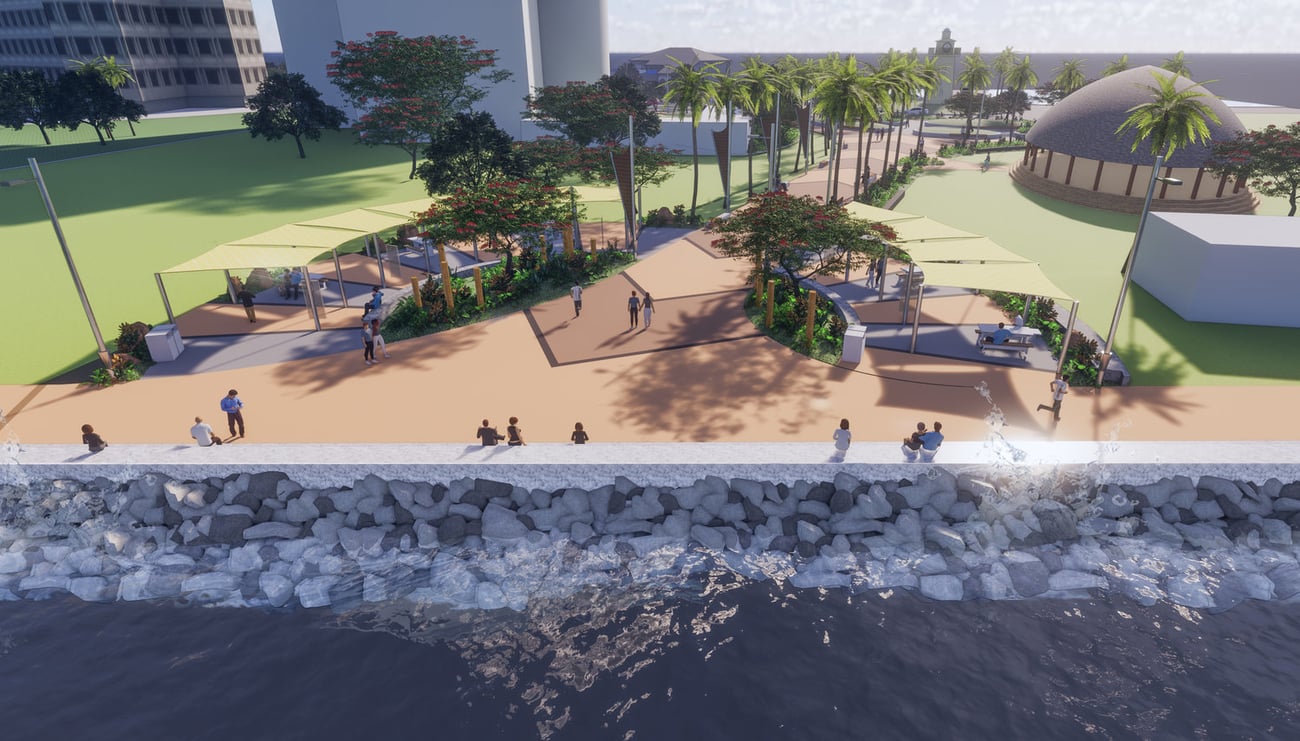Weaving architecture and culture: How design is being used to draw more tourists into Samoa

The New Zealand Aid Programme, which is managed by the Ministry of Foreign Affairs and Trade, is providing funding as part of a wider programme of support for a sustainable tourism industry in S?moa. Leading the design of these projects are Beca International Consultants with support from their local partner OSM Consultants. The design lead for the project, Tom Abbott, a Landscape Architect within the Beca Design Practice, says the two projects will be the first of many active aid funded projects to be realised, and it’s hoped they will encourage more visitors to spend time in central Apia.
“Like a lot of the Pacific Islands, tourism in Samoa is resort based – flying in and mini-bussing out to your resort destination and not seeing or spending any time in Apia,” he says. “So a big outcome for this project is about providing high quality open spaces to an international standard that tourists and locals will be attracted to.”

The waterfront in Apia before the development.
The Event Space, comprised of a ceremonial lawn area leading up to the Government Building steps, will be formalised by palm trees and shouldered by shaded parking areas and pedestrian connections either side. The annual Independence Day and Teuila Day Festivals attracts a crowd of thousands, so finding a balance of accommodating that many people but still maintaining usability throughout the year was a challenge, Abbott says.
Further to the west, the Clock Tower Boulevard project was to provide an important visual and pedestrian connection between the CBD and the coastal edge and inner reef. Large shade trees are incorporated into the design along the footpaths and seating spaces to make the site a comfortable place to be during the day. Five large sail structures – cultural interpretations of outrigger canoe sails – will line one side of the pedestrian boulevard. At the northern end of the boulevard large shade sails cover a social space with picnic tables and interpretation signage will connect the projects with adjacent Chinese development.

Render of the seating area on Apia’s planned Clock Tower Boulevard.
Abbott says one of the important considerations has been how to thread cultural narratives through the sites, so that the local artistic community feels ownership of the design elements. The cultural narrative below was identified by Beca and endorsed by the project’s cultural Advisory Group. The narrative uses a carefully selected ‘alagaupu’ and ‘muagagana’ (Samoan proverbial sayings) to capture the essence of the narrative.
These sayings are used by the Tulafale (oratory chiefs) and have their origins in the Samoan Myths and Legends, the history, and in the wisdom found in everyday life. As well as displaying the eloquence and artistry of the Samoan language, they provide small truths that provoke thought.
“Ua sau le va’a na tiu, tau mai i le va’a na tau ae o lo’o mamau pea lago o le va’a na fao afolau”
“One boat returns from the catch; the other is tied to the strand; the third one I propped up in the boat house.“

Samoan Prime Minister Tuilaepa Aiono Sailele Malielegaoi and Former NZ High Commissioner David Nicholson at the Ground-breaking Ceremony in Apia.
This proverb was the theme to the Golden Jubilee of Samoa’s Independence. To sustain the village, some go out to fish, others wait in the shallows to help with the catch, and the elders pray for success and a safe return from the shore. This reflects the journey of Samoa and its development as the first independent nation in the Pacific. Samoa’s constitution is based on Christian principles and Samoan Traditions. This has enabled Samoa to maintain a strong culture while embracing change, it also provides a strong foundation for future developments.
The groundbreaking ceremony has recently taken place with both projects moving from the design phase to construction. The ceremony was attended by the NZ High Commission and opened by the Prime Minister of Samoa.

Tree sourcing with MNRE rangers.
Delivering this type of landscape-led project in Apia has presented many challenges not only for the design team but also for local contractors who are not familiar with public realm projects of this scale. In particular the sourcing of materials has been challenging, Abbott says. “Fundamental landscaping materials have to be carefully considered from the outset”.
While Apia is blessed with stone quarries, unlike some of their south pacific neighbours, contractors have had to develop the supply of other materials such as turf and mulch specifically for this project, soil is also a precious commodity.
With the daily temperatures projected to increase over time, reducing the large areas of impervious car parking and increasing shade tree planting along the waterfront was identified early on as a big outcome for the project. The design has utilised several native tree species to reflect the surrounding bush clad ridgelines of Mt Vaea. Sourcing these trees involved accompanying local guides to handpick appropriate species for transplanting.
The project has also had to consider the climatic impact of the tropical cyclones that typically pass through the Island once a season. Storm events have influenced a lot of the structural design and material selection with strength and durability key to the furniture elements. “The cultural marker sails benefit from quick release fittings and can be raised and lowered with halyards which is unique to this project”.
Beca International Consultants and their local partner OSM would like to acknowledge the continued support of the Ministry of Works Transport and Infrastructure and Land Transport Authority for leading this tourism infrastructure project on behalf of the Government of Samoa and the NZ Ministry of Foreign Affairs and Trade.
-
This was originally published on Landscape Architecture Aotearoa.




